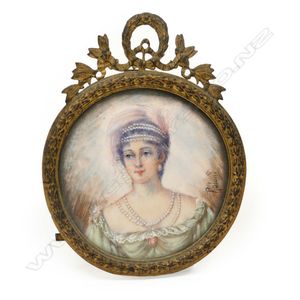Belle Epoque Woman Portrait Miniature by Roland
A portrait miniature painted on ivory of a woman in Belle Epoque dress signed Roland, circular in gilt metal frame with ribbon surmount and easel back, diameter 5.5 cm
You must be a subscriber, and be logged in to view price and dealer details.
Subscribe Now to view actual auction price for this item
When you subscribe, you have the option of setting the currency in which to display prices to $Au, $US, $NZ or Stg.
This item has been sold, and the description, image and price are for reference purposes only.
- Ivory - Ivory is a hard white material that comes from the tusks of elephants, mammoth, walrus and boar, or from the teeth of hippopotamus and whales. The ivory from the African elephant is the most prized source of ivory. Although the mammoth is extinct, tusks are still being unearthed in Russia and offered for sale.
Ivory has been used since the earliest times as a material for sculpture of small items, both in Europe and the east, principally China and Japan.
In Asia ivory has been carved for netsuke, seals, okimono, card cases, fan supports, animals and other figures and even as carved tusks.
In the last 200 years in Europe ivory has been used to carve figures, for elaborate tankards, snuff boxes, cane handles, embroidery and sewing accessories, in jewellery and as inlay on furniture. Its more practical uses include being used for billiard balls, buttons, and a veneers on the top of piano keys.
The use and trade of elephant ivory have become controversial because they have contributed to Due to the decline in elephant populations because of the trade in ivory, the Asian elephant was placed on Appendix One of the Convention on International Trade in Endangered Species (CITES), in 1975, and in January 1990, the African elephant was similarly listed. Under Appendix One, international trade in Asian or African elephant ivory between member countries is forbidden. Unlike trade in elephant tusks, trade in mammoth tusks is legal.
Since the invention of plastics, there have been many attempts to create an artificial ivory - Belle Epoque - The Belle Époque, also known as the "Beautiful Era," was a period in European history that lasted from the late 19th century to the outbreak of World War I in 1914. The term is most commonly associated with France, but is also used to refer to the same period in other countries, particularly in Western Europe and Latin America.
During the Belle Époque, Europe experienced a time of great prosperity and cultural, artistic, and scientific advancements. It was an era of peace and optimism, characterized by industrial growth, urbanization, and new technologies such as electricity, automobiles, and the telephone. The period is also associated with a flourishing of art and culture, particularly in the fields of literature, music, and the visual arts.
This item has been included into following indexes:
-
miniatures
- on ivory 353
- portrait and other 1,198
- signed by the artist 267
